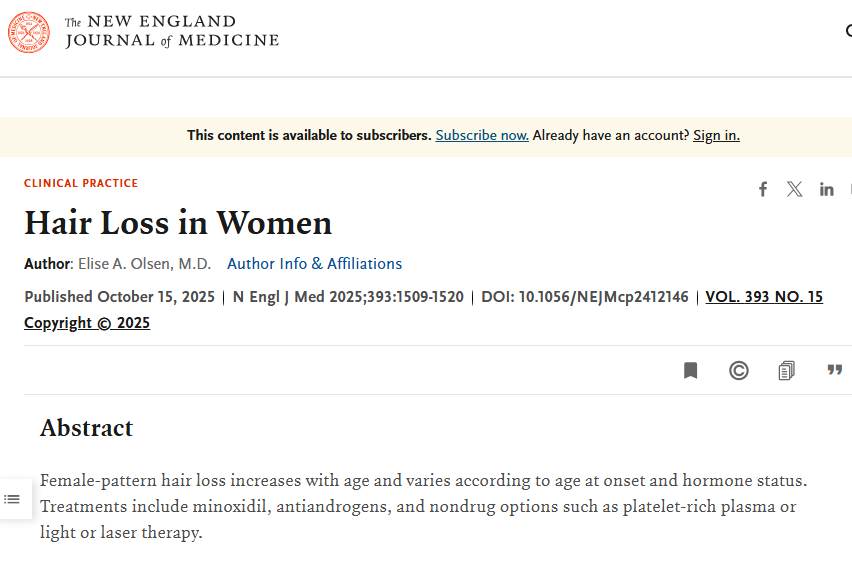Audio
Video
Introduction
The best lessons and pearls from clinical reviews featuring MGUS, inpatient hyponatremia, dermatologic emergencies, tinea infections, and hair loss in women.
Monoclonal Gammopathy Of Undetermined Significance Review (NEJM)

Source: https://www.nejm.org/doi/abs/10.1056/NEJMra2412716
Audio Summary
This is a terrific review of an oft misunderstood topic. I still shudder thinking about having to cross-cover patient inbox/results in residency when SPEPs were sent for basic outpatient neuropathy workup, they were mildly abnormal, and I then had interpret them and explain them to patients. This review clears a lot of those pain points up!
What MGUS Actually Means
- Your body is making a monoclonal protein (or “M-protein”).
- This protein is lots of identical antibodies from one clone of cells.
- The amount is low.
- There’s no damage to the body.
- And you feel totally normal.
- It’s NOT cancer, but it could become cancer.
Knowing this, MGUS itself is not treated.
Our job is to rule out actual myeloma at diagnosis, identify organ injury before it progresses, and then monitor based on risk.
Formal MGUS Definition
- Monoclonal (M) protein less than 3 g/dL
- Clonal plasma cell population in BM less than 10%
- Absence of end organ damage - no hypercalcemia, AKI, anemia, bone lesions (CRAB)
It’s common - it’s present in 5% of the adult population over 50!
The risk of progression from MGUS to a malignant plasma cell disorder (myeloma or Waldenstrom) is ~1% per year indefinitely; thus all require some cadence of surveillance.
All patients get an SPEP to quantify an M-spike
All patients get immunofixation to determine the type of heavy chain (IgG, IgA, IgM, etc.) and type of light chain (kappa, lambda)
All patients get serum free light chain (FLC) assay to check for a light chain clone or amyloidosis.
The Mayo Clinic Risk Model helps determine risk of progression
- M-protein concentration > 1.5 g/dL
- non-IgG isotype
- serum free light chain (FLC) ratio < 0.26 or >1.65
If 0 risk factors, 5% 20-year progression risk - monitor q2-3 years, don’t need a bone marrow
If 3 risk factors, 58% 20-year progression risk - monitor annually
If monoclonal protein causes organ dysfunction, it’s considered MGCS - “clinical significance”
It’s considered clinically significant if there is damage caused to organs via tissue deposition, autoantibody activation, or complement activation.
MGRS (“renal significance”) is an example - the M protein deposits in glomeruli which can lead to injury and ESKD
Others manifestations can include peripheral neuropathies, cryoglobulinemia, and other dermatologic conditions
We often treat MGCS with daratumumab or bortezomib based regimens to target the clonal population, reduce deposition, and prevent further damage.
Smoldering myeloma (SMM) has M-protein ≥ 3g/dL or BM ≥ 10% clonal plasma cells, but DO NOT have CRAB features. It has higher early progression risk for ~10% per year for the first 5 years.
AL Amyloidosis happens when a light chains misfold into sticky, abnormal shapes that assemble into long fibers called amyloid which the deposit in organs causing dysfunction (commonly nephrotic syndrome, restrictive cardiomyopathy, and neuropathies). Not all light chains will behave like this.
Don’t confuse AL amyloidosis with ATTR (transthyretin) amyloidosis (the Wild-type affects the heart most commonly), or AA amyloidosis which is caused by chronic inflammation and usually affects kidneys. They have a similar pathology of amyloid organ deposition, but the mechanism by which the amyloid forms is entirely different.
Inpatient Hyponatremia Management For The Hospitalist (Audio Digest)
Source: https://www.audio-digest.org/Courses/Inpatient-Hyponatremia-Management-for-the-Hospitalist/21347
Audio Summary
I use some of my CME money for the AudioDigest product and recommend it for those who like audio content.
The fundamentals of hyponatremia is one of those topics that you have to re-learn over and over again. It does get easier the more you deal with it in the hospital, but understanding the physiology helps to cement some of these lessons.
Here are some of my favorite high-yield takeaways.
As we all have been told, hyponatremia is not a sodium problem, its a water problem.
Paradoxically, patients with profoundly low sodium levels, when caused by reversible factors like thiazide diuretics, can have better outcomes than those with mild hyponatremia resulting from severe underlying conditions like cirrhosis, heart failure, or the SIADH.
The kidney is exceptionally adept at retaining sodium, an evolutionary trait from a sodium-poor environment. A random urine sodium measurement serves as an indirect marker of this. A low urine sodium (e.g., <25 mEq/L) strongly suggests the kidneys are retaining sodium in response to perceived volume depletion, regardless of what the physical exam might suggest. On the other hand, a higher urine sodium in the absence of diuretics implies the body does not perceive a volume deficit.
The urinary sodium often provides a more accurate assessment of a patient’s physiologically perceived volume than the physical exam ever can, especially in the ambiguous cases between euvolemia and mild hypovolemia.
In cases of hypovolemia, you became hyponatremic through salt loss (vomiting, diarrhea) and often increased free water intake due to thirst. The body prioritizes perfusion over tonicity by releasing ADH and retaining this free water.
Hypovolemic hyponatremia is fixed when you give isotonic fluid because it increases intravascular volume which turns off this ADH and allows for the kidney to pee out the excess free water that the patient took in.
In hypervolemia/third spacing, the low effective circulating volume reduces perfusion and impairs the kidneys ability to generate free water. Loop diuretics increase the delivery of fluid to the diluting segments of nephron and promote free water excretion.
SIADH most common cause of euvolemic hyponatremia
In SIADH, the issue is the body is making ADH INAPPROPRIATELY and so the body can’t get rid of the normal amount of free water it is taking in throughout the day.
You have to introduce more solute which functionally “drags” extra water out with it, even when ADH is chronically on. In other words, by increasing daily osmole excretion, you force the kidney to produce a higher minimum urine volume, even though ADH is high.
Salt tabs are actually a bad treatment for SIADH. By increasing thirst, salt tablets may paradoxically increase water intake and worsen hyponatremia if fluid intake exceeds the extra urine volume from salt-mediated solute diuresis.
Alternatively, urea (30-60g/day) is safe, effective, and inexpensive for chronic SIADH.
To achieve meaningful osmotic diuresis equivalent to 30g urea (which would lead to ~1L of water clearance), patients would need 15 grams of NaCl daily - far above typical salt tablet dosing.
Normal dietary sodium intake (∼100 mmol/day) already contains twice as much sodium as typical salt tablet doses (3g of salt stabs would be ~51 mmol)
Fluid restrictions work well but can be difficult to enforce, especially outside the hospital.
In acute settings, vaptans work well but can risk rapid overcorrection. A safer and more predictable option for severe, symptomatic cases is hypertonic saline. It works not by directly adding sodium but by acting as an osmotic diuretic; the administered salt load is excreted in a fixed, concentrated urine volume, obligating the excretion of free water (just like with urea).
A common pitfall that frequently prompts nephrology consultation is the phenomenon of desalination. This occurs when a patient with unrecognized SIADH is mistakenly treated for hypovolemia with normal saline. With ADH on, the kidneys excrete the administered salt load in a volume of urine that is smaller than the volume of saline infused. This results in the net retention of free water and a paradoxical worsening of the hyponatremia.
Dermatologic Emergencies in Primary Care (Audio Digest)
Source: https://www.audio-digest.org/CourseFlow?lid=21233&p=1
Audio Summary
I’ve been seeing a lot of unusual rashes over the last few months in the hospital. We recently saw AGEP probably from cefepime, erythroderma from immunotherapy, and an impressive likely drug eruption from and unknown cause. I’ve (luckily) only seen SJS a handful of times, last in residency. But its always helpful to remember the key defining characteristics so you can know when to involve derm colleagues on the urgent side.
Morbilliform Drug Eruption
- “maculopapular rash” - erythematous macules and papules that coalesce into blanchable patches and plaques
- typically appearing four to fourteen days after initiating a new medication
- intense pruritus common
- afebrile
- does not involve mucosa
- treat with topical steroids (0.1% triamcinolone cream) and antihistamines
- resolves over 1-2 weeks
Leukocytoclastic Vasculitis (LCV)
- palpable purpura, non-blanching
- may progress to bullae, ulcers, necrosis
- commonly lower legs, feet, back, buttocks
- can be caused by COVID-19 and hepatitis, autoimmune diseases such as lupus, malignancies, and a wide array of drugs
Acute Generalized Exanthematous Pustulosis (AGEP)
- rapid-onset condition where patients develop numerous, monomorphic, pinpoint pustules on an erythematous base, typically within two days to two weeks of an inciting event
- almost always persistent high fevers
- often burning and itching
- often starts on face and intertriginous areas
- penicillins and cephalosporins are most commonly implicated
- AGEP is distinguished from DRESS by the presence of pustules and the absence of atypical lymphocytes on a blood smear
- stop the offending drug, give acetaminophen, topical steroids
Phototoxic Drug Reactions
- exaggerated sunburn with erythema, edema, blistering
- UVA penetrates window glass so patients might not realize they had sun exposure
- NSAIDs, tetracyclines, HCTZ, and voriconazole are commonly associated
Erythema Multiforme
- classic targetoid lesions with three distinct color zones
- commonly on hands and feet
- 90% of adult cases are attributable to HSV - rash can be seen before or concomitantly with the infection
- steroids avoided given the etiology is often viral; prevents rebound
- key DDx is Steven Johnson Syndrome
Erythroderma
- erythema and scalding affecting over 90% BSA
- its an end-stage inflammatory reaction pattern with many possible triggers
- onset is days to months
- systemic complications - hair loss, nail dystrophy, peripheral edema, lymphadenopathy, high-output heart failure (widespread vasodilation), thermoregulatory disturbance
- common to have pre-existing dermatoses like psoriasis or eczema or CTCL like Sezary Syndrome
- allopurinol is a frequent offender
- true emergency - immediate hospitalization - need fluids, electrolyte correction, temperature regulation
DRESS (Drug Rash with Eosinophilia and Systemic Symptoms)
- delayed hypersensitivity reaction 2-8 weeks after drug initiation
- morbilliform eruption, fever, eosinophilia
- commonly painless lymphadenopathy
- commonly multi-organ involvement - often hepatitis
- high risk drugs are AEDs and allopurinol
- RegiSCAR score to diagnose
- need to treat with systemic steroids with slow taper over weeks to months to prevent relapse
SJS/TEN
- the ultimate derm emergency - need to be treated in a burn unit or ICU setting
- mucocutaneous disease caused by widespread keratinocyte apoptosis
- leads to skin pain (hallmark), blistering, epidermal detachment
- SJS <10% BSA ; TEN >30% BSA - anything in between is considered “overlap”
- fever and malaise are common
- mucosal involvement of oral, ocular, genital tracts is near universal - can lead to blindness and strictures
- SCORTEN scale used to predict mortality
- anticonvulsants, allopurinol, and sulfa antibiotics common culprits
- mainstay is aggressive supportive care
- additional therapy is controversial - will sometimes give IVIG or TNF-alpha inhibitors
Diagnosis and Management of Tinea Infections - AAFP Review

Source: https://pubmed.ncbi.nlm.nih.gov/41118183/
Audio Summary
For some reason, these infections always confused me in clinic. It’s probably because the names are confusing and used to signify different disease processes. I do feel like this review helped make some of the decision-making a bit more straight-forward.
Infections involving hair follicles (tinea capitis) or nail plate (onychomycosis) require systemic therapy.
Terbinafine is fungicidal and concentrates well in the skin, hair, and nails.
Oral terbinafine 4-6 weeks for tinea capitis.
6 weeks for fingernails.
12 weeks for toenails.
A Cochrane review confirms its superiority of terbinafine over older agents like griseofulvin for tinea capitis.
While liver injury is a known potential side effect, it is rare. Baseline liver function tests are reasonable, but routine monitoring is generally not required in healthy patients without underlying liver disease.
Confirm onychomycosis with lab testing (PAS stain or KOH prep or fungal culture) before committing to treatment.
Mimics of onychomycosis include psoriasis, lichen planus, traumatic nail dystrophy.
When using topicals to treat tinea infections, don’t use steroids as they will suppress local immune response allowing dermatophytes to proliferate into tinea incognito.
Resistant infections often require longer treatment courses with alternative agents, such as itraconazole, and may necessitate specialized diagnostic testing like fungal culture
Hair Loss In Women (NEJM)

Source: https://www.nejm.org/doi/abs/10.1056/NEJMcp2412146
Audio Summary
Nice to see this topic highlighted in NEJM. It came up sparingly in my outpatient clinic, but seems to be more in the zeitgeist given the DTC medical companies heavily focus on hair loss as one of their main offerings. I found it helpful to know when to involve derm.
First, distinguish non-scarring vs scarring alopecia; erythema, scale, loss of follicular openings, shiny skin, or focal patches of complete loss should prompt urgent derm referral
In female-pattern hair loss (FPHL), the part in the middle of the scalp slowly gets wider and can look like a “Christmas tree” shape when you look from above, but the front hairline usually stays where it is.
In chronic telogen effluvium, the scalp can still look fairly full, but a lot of hair comes out in the shower or on the brush, sometimes so much that people bring a bag of hair to show how much they’re losing.
Alopecia areata causes clear, round bald spots with short, broken “exclamation point” hairs around the edges and sometimes small dents in the fingernails.
Differentiating FPHL from Chronic Telogen Effluvium (CTE) is a common clinical challenge and the two conditions can also coexist.
FPHL is a diagnosis of thinning due to follicular miniaturization, while CTE is a diagnosis of excessive shedding.
CTE is characterized by a diffuse increase in hair shedding across the entire scalp, often precipitated by a physiologic or emotional stressor 2-3 months prior (major illness, surgery, childbirth, significant weight loss). The hair pull test is typically positive in CTE (more than 10% of grasped hairs are removed).
Review meds and recent stressors (illness, surgery, childbirth, rapid weight loss, new drugs) for chronic telogen effluvium triggers.
FPHL can be in the Olsen pattern or the Ludwig pattern.
Check for signs of hyperandrogenism and rule out common metabolic contributors including hirsutism, cystic acne, irregular menses, virilization.
Send total and free testosterone, DHEA-S, CBC, ferritin, TSH, and vitamin D.
Minoxidil 5% foam daily or 1mg oral minoxidil daily is cornerstone therapy for FPHL. It prolongs anagen (growth) phase of hair cycle and improves follicular blood flow.
A period of initial shedding is common in first 1-2 months of treatment with minoxidil and means medication is working. True regrowth takes 6-12 months, and treatment is usually long term.
A common side effect is hypertrichosis - unwanted hair growth on other parts of the face and body.
If hyperandrogenism is present, spironolactone or finasteride are second-line options.
Finasteride is contraindicated in pregnancy. Ensure reliable contraception with systemic antiandrogens and oral minoxidil.
Counsel patients to avoid tight hairstyles, chemical relaxers, excessive heat, and rough brushing that worsen traction or breakage, and normalize the use of camouflage strategies (hair fibers, powders, part-shifting, hairpieces) while medical therapy takes effect.
Recognize that female hair loss is strongly associated with anxiety, depression, and body-image distress, and explicitly validate this while considering brief screening for mood or anxiety disorders when appropriate.
Consider dermatology referral and possible scalp biopsy for atypical patterns, rapid progression, pain or pruritus, clear scarring features, focal patches, or failure to respond to standard female-pattern hair loss therapy.







.png)
